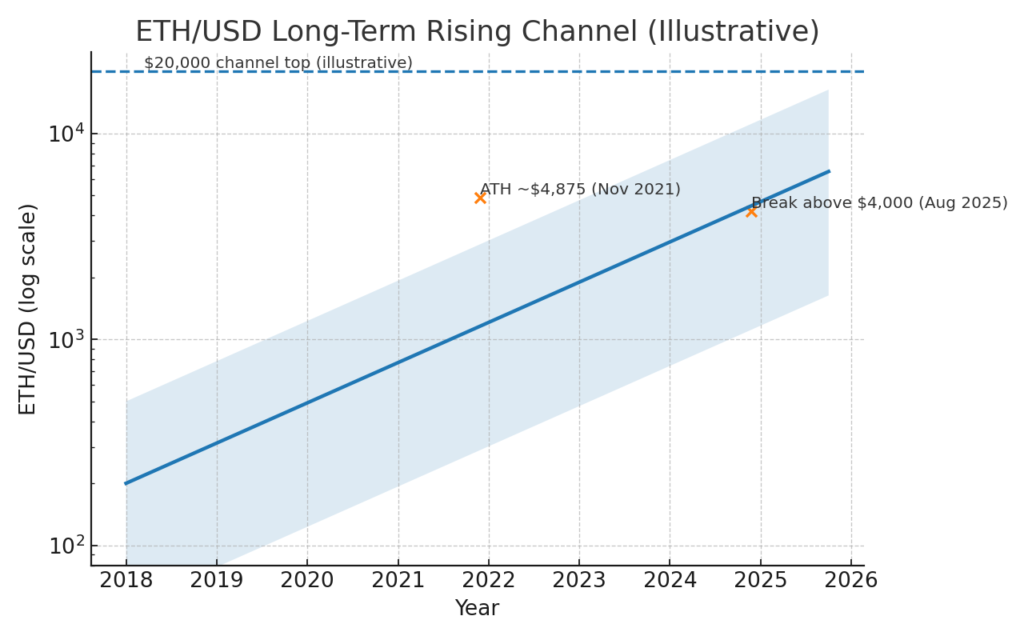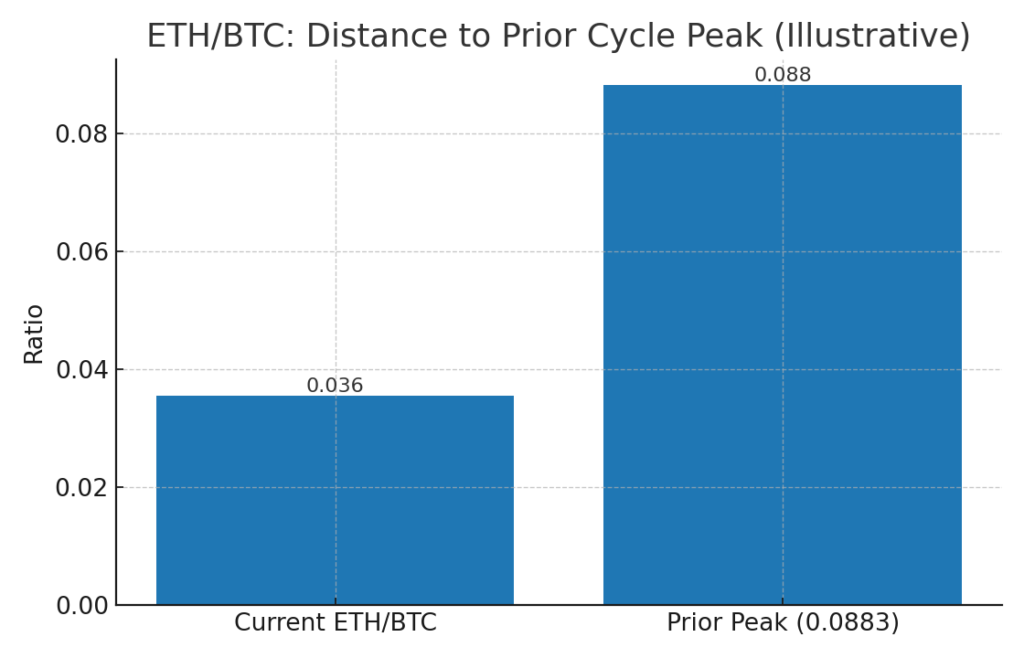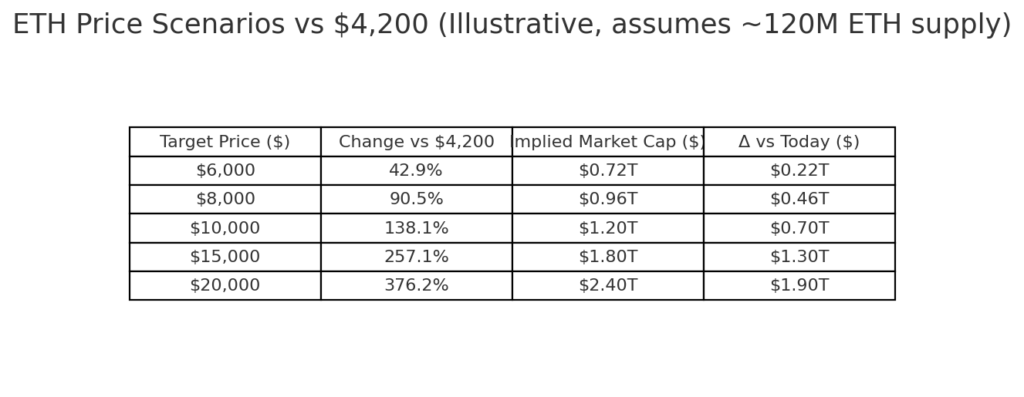
Main takeaways:
- ETH’s break above $4,000 and a surge to ~$4,200 coincided with heavy short liquidations, resetting bullish momentum to the highest levels since December 2021.
- A widely watched multi-year rising channel implies room toward $20,000 if momentum persists; the idea gained attention after trader Merlijn’s “375%” projection.
- Versus BTC, ETH would still need roughly +150% to revisit its prior cycle peak at 0.0883, highlighting catch-up potential but also relative-strength risk.
- Structural tailwinds include spot ETH ETFs (approved in 2024; improving flows in 2025) and the Dencun/EIP-4844 upgrade, which dramatically lowered L2 settlement costs.
- Near-term risks include broader BTC pullbacks (e.g., CME futures gap dynamics) and crowded positioning. Risk management remains essential.
1) The set-up: ETH clears $4,000 and prints the strongest weekly close in years
Ethereum’s climb through $4,000—followed by a burst to roughly $4,200—wasn’t just a round-number breakout. Data over the weekend showed sizeable short liquidations (about $207 million), which helped propel ETH to its highest levels since December 2021. The sequence—a resistance break, a liquidity air-pocket above, and forced buying from shorts—reset momentum and brought “price discovery” talk back into the conversation.
For context, this rally builds on months of structural shifts. The U.S. approved spot ETH ETFs in 2024 (trading began July 2024), and 2025 has seen improving institutional plumbing and flows. The SEC’s green light for in-kind mechanisms (for BTC and ETH) is widely viewed as a liquidity enhancement for large allocators who prefer to move underlying assets rather than cash for creations/redemptions.
[Insert Figure 1: “ETH/USD Long-Term Rising Channel (Illustrative)” here]

2) The $20,000 thesis: a long-term channel that traders can anchor to
A popular chart making the rounds frames ETH within a multi-year rising channel. The argument: ETH has historically oscillated within this structure, and prior touches of the upper bound preceded powerful advances—including the November 2021 all-time high near $4,875. If the current swing extends to the channel top, some traders eye an eventual path toward $20,000 (roughly +375% from the mid-$4,000s). Importantly, even proponents concede that such levels usually require time, interim consolidations, and macro tailwinds.
From a market-structure standpoint, the channel offers a pragmatic framework: it’s not a guarantee, but it’s a way to manage scenarios—e.g., defining invalidation if ETH loses the channel midline, or planning scale-outs near the upper bound. In practical allocation terms, this helps traders plan around volatility clusters while keeping the “big picture” intact.
3) ETH vs BTC: the relative-value frontier
The bullish USD chart doesn’t automatically translate into BTC-relative outperformance. A month after recording its USD all-time high in late 2021, ETH printed a cycle peak versus BTC around 0.0883. Getting back there from today’s area would require about +150% in ETH/BTC terms. This is both a risk and an opportunity: if BTC chops sideways or corrects, ETH can lose relative strength; if fresh ETH-specific inflows arrive (e.g., ETF demand or L2-driven activity), ETH could start closing that gap.
[Insert Figure 2: “ETH/BTC — Distance to Prior Cycle Peak” here]

4) Structural tailwinds: ETFs, flows, and cheaper block space
Spot ETH ETFs
The 2024 approval of spot ETH ETFs was a turning point, giving institutions direct exposure without on-chain ops. The products launched in July 2024, and 2025 has seen improving fund mechanics and periods of strong net inflows—e.g., reports of multi-week positive flow streaks and expanding AUM for leading issuers. These flows can be lumpy, but they add a recurring source of demand and price-insensitive rebalancing.
Dencun/EIP-4844 and Layer-2 economics
The Dencun upgrade—especially EIP-4844 (proto-danksharding)—materially changed the cost structure for Ethereum’s scaling stack. By introducing “blob” data and a separate fee lane, it slashed L2 data-availability costs, allowing rollups to settle back to mainnet more cheaply. This has already translated into markedly lower transaction costs on L2s and spurred growth in L2 activity, which deepens ETH’s utility as the settlement and security layer.
Why this matters to price
When using Ethereum becomes cheaper and faster (via L2s), more activity—payments, stablecoin transfers, DeFi lending, NFT minting, gaming—can migrate onto the ecosystem. That activity drives gas usage (including MEV dynamics and priority fees), staking demand, and long-horizon developer investment. Over time, this can reinforce a durable bid for ETH, particularly if ETF demand syncs with on-chain usage growth.
5) What’s new in the data: momentum, liquidations, and the “flippening” chatter
The most recent push through $4,000 immediately revived “flippening” debates, as ETH briefly traded above ~$4,300 and BTC dominance slipped. While “flippening” timelines are speculative and depend on both chains’ narratives, the key takeaway is that ETH’s fundamental and market structure story has strengthened across multiple fronts—costs, liquidity access, and developer traction—even if relative-performance catch-up is still substantial.
On the micro side, weekend liquidations show positioning remains fragile; swift squeezes can carry price farther than models imply, but can also reverse quickly once forced flows subside. For participants, this argues for staggered entries/exits and predefined invalidation points rather than all-in bets.
6) Risks to the bullish view: macro, flows, and BTC gravity
Two near-term risks stand out. First, BTC’s own technical backdrop: futures-market “gaps” on CME often get filled, and recent price action indeed revisited a July gap near $114,000. If BTC weakens to fill new gaps, beta assets—including ETH—can retrace sharply. Second, ETF flows can swing from positive to flat/negative, hitting price through reduced daily demand. Risk management here means position sizing for volatility, keeping dry powder for drawdowns, and avoiding leverage that can force you out at the wrong time.
7) For builders: where the real users are showing up
Stablecoins & payments on L2
Cheaper L2 block space has drawn stablecoin flows to rollups (e.g., Arbitrum, Optimism, Base). For product teams, this creates clearer unit economics for payment rails, payroll, and remittance applications that can settle back to Ethereum’s security at a fraction of historical costs. For fintech integrators, the combination of L2 rails with off-ramp partners could unlock B2B use cases in commerce and cross-border settlement.
Programmable compliance and tokenization
Institutional interest in tokenized cash and securities continues to rise. Large asset managers have publicly emphasized tokenization’s efficiency, and on-chain money-market funds are no longer theoretical. Builders who can bridge regulated requirements with L2-native UX—without sacrificing security—are positioned to capture the next wave of enterprise demand.
Developer guidance
Prioritize chains and rollups where user costs are structurally low post-Dencun and liquidity is deepest. Abstract gas for end-users where possible; rely on audited account-abstraction libraries to simplify onboarding. Plan for portability across the OP Stack/Superchain or zk rollups to avoid over-concentration risk.
8) For investors hunting new revenue: practical angles
- Staking and restaking: Yield from staking can be a core base-return; assess protocol risk, lockups, and liquid staking token liquidity. Diversify across providers and understand any restaking risks before chasing boosted APYs.
- L2 ecosystems: Sequencer and L2 governance tokens benefit from higher throughput and fees as usage climbs. Consider a basket approach across major rollups with clear fee capture and revenue sharing.
- ETF basis trades: Some investors deploy relative-value strategies between spot, ETFs, and futures; these demand careful execution, margin, and tax awareness.
- Infrastructure picks: Index exposure to ETH beneficiaries—RPC, data availability, MEV tooling—can provide picks-and-shovels upside.
- Stablecoin businesses: Lower L2 costs make merchant settlement, on/off-ramp aggregation, and cross-border SME services more viable.
9) Scenarios and levels to watch
To organize thinking, consider a few waypoints from ~$4,200:
[Insert Figure 3: “ETH Price Scenarios vs $4,200 (Illustrative)” here]

- $6,000: Achievable under continued ETF inflows and healthy risk appetite; would likely coincide with strong L2 metrics and sustained on-chain activity.
- $8,000–$10,000: Requires a second-leg impulse, either via outsized ETF demand or a broader rotation into ETH-beta assets; watch ETH/BTC for confirmation.
- $15,000–$20,000: A channel-top type move that typically needs many months, supportive macro, and a clear ETH-specific narrative (e.g., structural fee growth from L2 activity). Pullbacks of 25–40% would still be “normal” inside such an advance.
10) Checklist before you size up
- Weekly close above prior resistance and acceptance above $4,000–$4,200?
- ETF flow trend (multi-day positive streaks) intact?
- BTC not magnetized by fresh CME gaps? If yes, consider tighter risk.
- L2 fees and throughput stable post-Dencun; no major reorg/DA incidents?
Conclusion
ETH’s break above $4,000 has re-energized a secular bull thesis that blends technical momentum with structural adoption. The $20,000 “channel-top” call is not a promise, but it’s a helpful scaffold for thinking in scenarios and managing risk. Crucially, today’s market is not just narratives: spot ETFs channel traditional capital into ETH; Dencun/EIP-4844 reshaped the cost base for rollups, inviting real users; and L2 activity broadens the addressable market for payments, DeFi, and tokenization. There will be shakeouts—especially if BTC wobbles—but for disciplined traders and practical builders, the path from $4,000 to the next phase is clearer than it has been in years.

